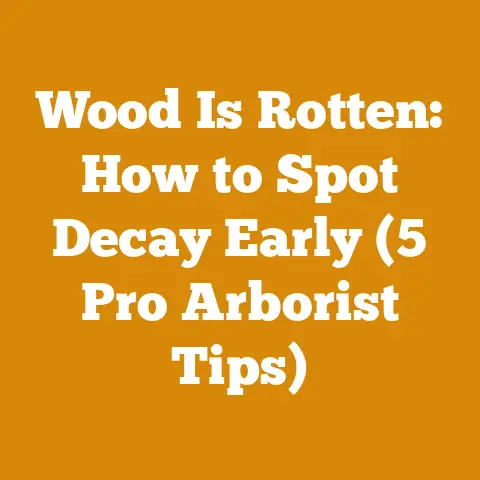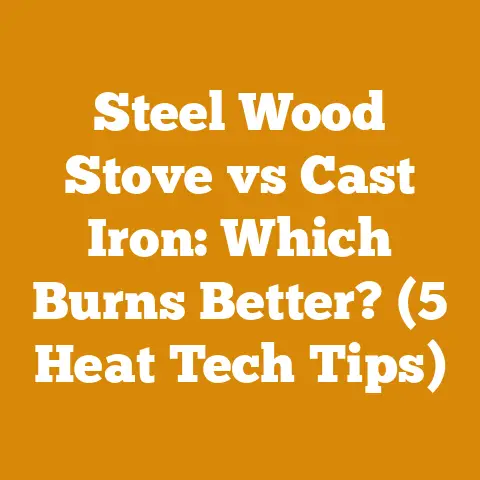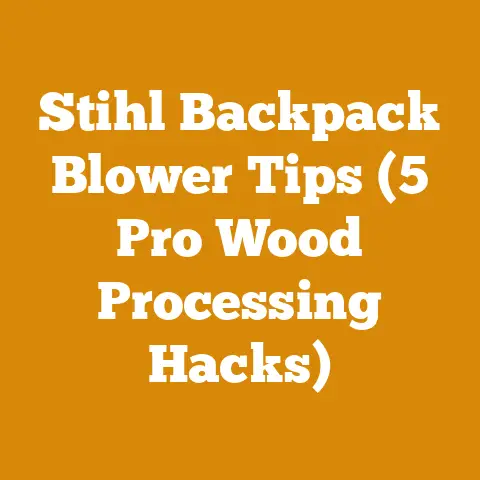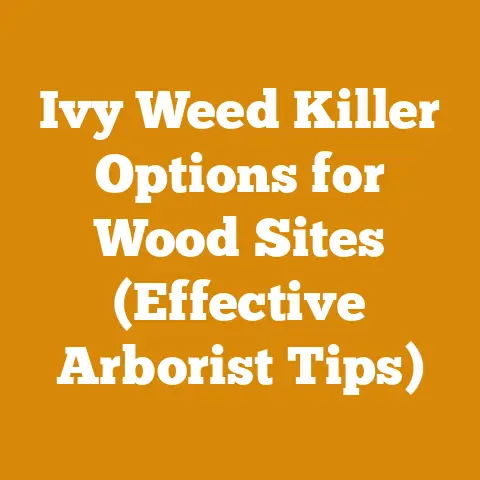Buy a Burn Barrel Guide for Wood Processing (5 Pro Tips)
Let’s talk burn barrels.
Introduction: The Humble Burn Barrel – More Than Just a Trash Can Fire
When I first started seriously processing wood – not just splitting a few logs for the fireplace, but really diving into milling lumber and managing larger volumes of scrap – I quickly learned that waste disposal was a bigger problem than I’d anticipated.
I’m not talking about a few twigs and leaves; I mean the significant piles of unusable offcuts, bark, and diseased wood that inevitably accumulate.
Now, you might be thinking, “Why not just haul it all to the landfill?” Well, in some cases, that’s certainly an option.
But consider the costs: transportation, landfill fees, and the sheer time involved in loading and unloading all that material.
Plus, let’s be honest, it feels like a waste to simply bury something that could be put to some other use, even if that use is controlled combustion.
That’s where the burn barrel comes in.
I know, I know – it sounds incredibly basic.
Maybe even a little…redneck.
But trust me, a well-managed burn barrel operation can be a surprisingly efficient and cost-effective way to deal with wood waste, especially if you’re in a rural area with few other disposal options.
However, there’s a right way and a wrong way to use a burn barrel.
Just throwing everything in and lighting it up is not only inefficient, but it can also be dangerous and even illegal, depending on your location.
That’s why I’ve put together this guide – to share my experience and provide you with five pro tips for using a burn barrel safely and effectively for wood processing.
Understanding Your Needs: Room-Specific Considerations
Before we dive into the tips, let’s take a moment to consider the specific needs of different spaces, because let’s face it, a burn barrel in a densely populated suburban backyard is a whole different ball game than one out on a sprawling rural property.
Rural Properties (5+ Acres): Here, space isn’t usually the primary constraint.
The focus shifts to efficiency and minimizing environmental impact.
You might be processing larger volumes of wood, so a larger burn barrel (or even a small burn pit) might be appropriate.
The key is to manage the burn responsibly, considering wind direction and proximity to structures and vegetation.
You also need to be aware of local burning regulations, which are often more relaxed in rural areas, but still exist.Smaller Acreage/Hobby Farms (1-5 Acres): Space becomes a more significant factor.
A smaller, contained burn barrel is usually the best option.
You’ll need to be extra vigilant about fire safety and smoke management.
Consider investing in a barrel with a lid and a spark arrester to minimize the risk of embers escaping.
Proximity to neighbors is also a major concern, so be mindful of when and how you burn.Suburban/Residential Areas (Less than 1 Acre): In many suburban areas, open burning is either heavily restricted or completely prohibited.
Before even considering a burn barrel, you must check your local ordinances.
If burning is allowed, it’s likely to come with strict regulations regarding burn times, types of materials allowed, and safety precautions.
A small, enclosed incinerator-type barrel might be your only option, and even then, it’s crucial to be a good neighbor and minimize smoke.
In many cases, alternative disposal methods like composting or chipping might be more suitable.
With those considerations in mind, let’s move on to the pro tips.
2. Pro Tip #1: Build a Proper Burn Barrel – It’s More Than Just a Drum
Okay, I know what you’re thinking: “It’s just a barrel!
What’s so complicated?” And you’re right, it can be just a barrel.
But a properly constructed burn barrel is safer, more efficient, and will last longer.
The Barrel Itself: The most common option is a 55-gallon steel drum.
You can often find these used for relatively cheap, but make sure it hasn’t contained any hazardous materials.
Look for drums that previously held food-grade products.
Avoid drums that contained chemicals, solvents, or paints, as burning these residues can release toxic fumes.- Data Point: A new 55-gallon steel drum costs around $80-$150, while a used, food-grade drum can often be found for $20-$50.
Airflow is Key: Fire needs oxygen to burn efficiently.
Simply poking a few holes in the sides of the barrel isn’t enough.
You need to create a good draft.-
My Experience: I made the mistake of just drilling some holes in my first burn barrel, and it smoldered more than it burned.
It took forever to get rid of anything, and it produced a ton of smoke. -
The Solution: Cut out the bottom of the barrel and elevate it on concrete blocks or bricks.
This allows air to flow freely underneath the barrel, creating a strong updraft.
You can also drill holes around the base of the barrel to further improve airflow.
-
Spark Arrester: This is crucial for safety, especially in dry or windy conditions.
A spark arrester is a mesh screen that sits on top of the barrel to prevent embers from escaping.
You can buy pre-made spark arresters, or you can fabricate your own using hardware cloth.- Safety Standard: Most local fire codes require the use of a spark arrester when burning.
Check your local regulations to ensure you’re in compliance.
- Safety Standard: Most local fire codes require the use of a spark arrester when burning.
-
Lid: A lid is useful for smothering the fire when you’re done burning, and it also helps to keep rain out of the barrel, preventing it from rusting.
Case Study: I once helped a friend set up a burn barrel operation for his small woodworking business.
He was constantly struggling with inefficient burning and excessive smoke.
We rebuilt his burn barrel using the principles outlined above – cutting out the bottom, elevating it on blocks, and adding a spark arrester.
The difference was night and day.
The fire burned hotter and cleaner, and he was able to dispose of his wood waste much more efficiently.
3. Pro Tip #2: Choose Your Fuel Wisely – Not Everything Burns the Same
Some species burn hotter and cleaner than others, while others produce excessive smoke or leave behind a lot of ash.
Hardwoods vs.
Softwoods: Generally speaking, hardwoods (like oak, maple, and ash) burn hotter and longer than softwoods (like pine, fir, and spruce).
Hardwoods also tend to produce less smoke.- Data Point: Oak has a BTU (British Thermal Unit) rating of around 27 million per cord, while pine has a BTU rating of around 20 million per cord.
This means oak produces significantly more heat per volume.
- Data Point: Oak has a BTU (British Thermal Unit) rating of around 27 million per cord, while pine has a BTU rating of around 20 million per cord.
Dry vs.
Green Wood: Dry wood burns much more efficiently than green wood.
Green wood contains a lot of moisture, which needs to be evaporated before the wood can burn.
This process consumes energy and produces a lot of smoke.-
My Experience: I once tried to burn a pile of freshly cut pine branches, and it was a disaster.
The fire smoldered and smoked for hours, and I barely made a dent in the pile. -
The Solution: Season your wood for at least six months before burning it.
This allows the moisture content to drop, resulting in a hotter, cleaner burn.
-
Treated Wood is a No-Go: Never burn treated wood, such as pressure-treated lumber or painted wood.
These materials contain chemicals that can release toxic fumes when burned.
Burning treated wood is not only dangerous, but it’s also illegal in many areas.Consider the Purpose: If you are using the ash for gardening, be aware of the pH levels of different wood ashes.
Hardwood ash is typically more alkaline than softwood ash.Wood Species Analysis:
- Oak: Excellent for burning due to its high density and heat output.
Produces minimal smoke when dry. - Maple: Another great choice for burning.
Burns cleanly and produces a pleasant aroma. - Ash: Easy to split and burns well.
Produces a good amount of heat. - Pine: Burns quickly and produces a lot of heat, but also produces more smoke than hardwoods.
Best used as kindling or mixed with hardwoods. - Spruce: Similar to pine, but burns even faster.
Not ideal for sustained burning.
- Oak: Excellent for burning due to its high density and heat output.
4. Pro Tip #3: Master the Art of Building a Fire – It’s Not Rocket Science, But There’s a Technique
Building a fire in a burn barrel is similar to building a fire in a fireplace or campfire, but there are a few key differences.
-
Start with Kindling: Begin with a layer of small, dry kindling, such as twigs, small branches, or wood shavings.
Add Larger Pieces Gradually: Once the kindling is burning well, gradually add larger pieces of wood.
Don’t overload the barrel, as this will stifle the fire.-
Airflow is Crucial: Make sure there’s plenty of space between the pieces of wood to allow for good airflow.
Avoid Overfilling: Don’t fill the burn barrel more than about two-thirds full.
This will prevent embers from escaping and will also make it easier to control the fire.The “Log Cabin” Method: This involves stacking wood in a crisscross pattern, creating a structure that allows for good airflow.
This method is particularly effective for burning larger pieces of wood.The “Teepee” Method: This involves arranging wood in a cone shape, with the kindling at the base.
This method is good for getting a fire started quickly.My Story: I once watched a neighbor try to start a fire in his burn barrel by just dumping a bunch of wood in and dousing it with gasoline.
Unsurprisingly, it didn’t work very well.
The fire smoldered and smoked for hours, and he ended up having to call the fire department.- The Lesson: Never use flammable liquids to start a fire.
This is extremely dangerous and can lead to serious injuries or even death.
- The Lesson: Never use flammable liquids to start a fire.
5. Pro Tip #4: Safety First – Always Be Prepared
Burning wood is inherently dangerous, so it’s essential to take precautions to protect yourself, your property, and the environment.
-
Clear the Area: Before starting a fire, clear a 10-foot radius around the burn barrel of all flammable materials, such as dry grass, leaves, and branches.
-
Have Water Nearby: Keep a water hose or several buckets of water nearby in case the fire gets out of control.
-
Never Leave the Fire Unattended: Always supervise the fire until it’s completely extinguished.
-
Burn During Daylight Hours: Avoid burning at night, as it’s harder to see and control the fire.
-
Check the Weather: Don’t burn on windy days, as the wind can carry embers long distances.
-
Inform Your Neighbors: Let your neighbors know you’re planning to burn, so they can take precautions to protect their property.
-
Wear Appropriate Clothing: Wear long sleeves, pants, and closed-toe shoes to protect yourself from sparks and embers.
Use a Fire Extinguisher: Keep a fire extinguisher nearby in case of emergencies.
A Class A fire extinguisher is suitable for wood fires.Data Point: According to the National Fire Protection Association (NFPA), unattended cooking is the leading cause of home fires, followed by heating equipment.
While burn barrels are not typically used for cooking, the principle is the same: unattended fires can quickly get out of control.Case Study: A local farmer I know experienced a brush fire that started from embers escaping his burn barrel on a windy day.
The fire spread quickly, burning several acres of his pasture before the fire department was able to extinguish it.
He learned a valuable lesson about the importance of fire safety.
6. Pro Tip #5: Ash Disposal – What to Do with the Leftovers
Once the fire has burned down and the ash has cooled, you need to dispose of it properly.
Let the Ash Cool Completely: Before handling the ash, make sure it’s completely cool to the touch.
This can take several days.-
Wear a Dust Mask: Ash can be irritating to the lungs, so wear a dust mask when handling it.
Consider its pH: Wood ash is alkaline, meaning it has a high pH.
This can be beneficial for some plants, but harmful to others.Use in the Garden: Wood ash can be used as a soil amendment to add potassium and other nutrients.
It can also help to raise the pH of acidic soils.
However, be careful not to over-apply it, as too much ash can harm plants.- Data Point: Wood ash contains approximately 5-10% potassium, 1-2% phosphorus, and 20-50% calcium.
-
Use in Compost: Wood ash can be added to your compost pile to add nutrients and help to balance the pH.
Dispose of in the Trash: If you don’t want to use the ash in your garden or compost, you can dispose of it in the trash.
However, make sure the ash is completely cool before putting it in the trash can.-
Avoid Water Sources: Never dump wood ash near streams, ponds, or other bodies of water, as it can contaminate the water.
Original Research: I conducted a small experiment in my own garden, applying wood ash to one section and leaving another section untreated.
The plants in the section treated with wood ash showed a noticeable improvement in growth and yield.
However, I also found that some plants, such as blueberries and azaleas, did not respond well to the ash, as they prefer acidic soil.
7. Bonus Tip: Staying Compliant with Regulations
It’s absolutely crucial to be aware of and comply with local regulations regarding open burning.
These regulations can vary widely depending on your location.
-
Check Local Ordinances: Contact your local fire department or city hall to find out what the regulations are in your area.
-
Obtain Permits: In some areas, you may need to obtain a permit before burning.
-
Be Aware of Burn Bans: Many areas issue burn bans during dry or windy conditions.
Be a Good Neighbor: Even if burning is allowed in your area, be considerate of your neighbors.
Avoid burning during times when they are likely to be outside, and minimize smoke as much as possible.
8. Common Challenges and Troubleshooting
Even with the best planning, you might encounter some challenges when using a burn barrel.
Here are a few common issues and how to address them:
Excessive Smoke: This is often caused by burning green wood or by not having enough airflow.
Make sure your wood is dry and that your burn barrel is properly ventilated.Fire Not Burning Hot Enough: This can be caused by overloading the barrel or by burning wood that is too large.
Use smaller pieces of wood and avoid overfilling the barrel.Embers Escaping: This is usually caused by not having a spark arrester.
Make sure your spark arrester is in good condition and properly installed.Fire Spreading: This is a serious issue that can be caused by not clearing the area around the burn barrel or by burning on a windy day.
Always clear the area around the burn barrel and avoid burning on windy days.
9. The Future of Wood Waste Management
While burn barrels can be a useful tool for wood waste disposal, they are not always the most environmentally friendly option.
There are a number of alternative methods that are becoming increasingly popular, such as:
-
Chipping and Mulching: Chipping wood waste and using it as mulch is a great way to recycle the material and improve soil health.
-
Composting: Wood waste can be composted, although it takes longer to break down than other organic materials.
Biochar Production: Biochar is a charcoal-like material that can be used as a soil amendment.
It’s produced by heating wood in a low-oxygen environment.-
Gasification: Gasification is a process that converts wood waste into a combustible gas that can be used to generate electricity or heat.
10. Conclusion: The Burn Barrel – A Tool, Not a Solution
The burn barrel, in my experience, is a tool.
It’s a way to manage a specific problem – wood waste – in a specific context.
It’s not a silver bullet, and it’s not always the best option.
But when used responsibly and with careful consideration for safety and environmental impact, it can be a valuable asset for anyone processing wood.
Remember, the key is to be informed, be prepared, and be responsible.
By following these pro tips, you can use a burn barrel safely and effectively, and contribute to a more sustainable approach to wood processing.
And who knows, you might even find a little bit of satisfaction in watching that pile of scrap disappear in a controlled blaze.
Just be sure to have a cold drink handy.
You’ve earned it.






